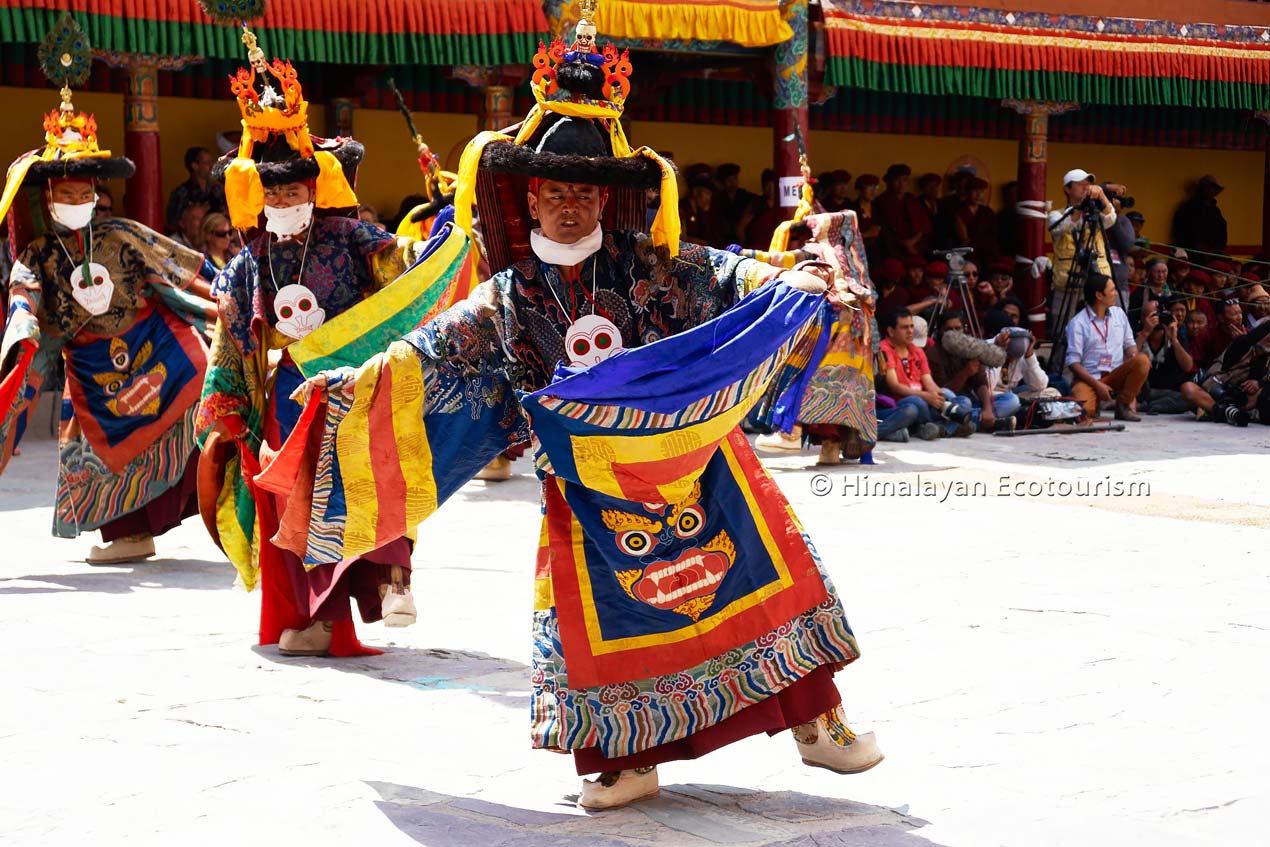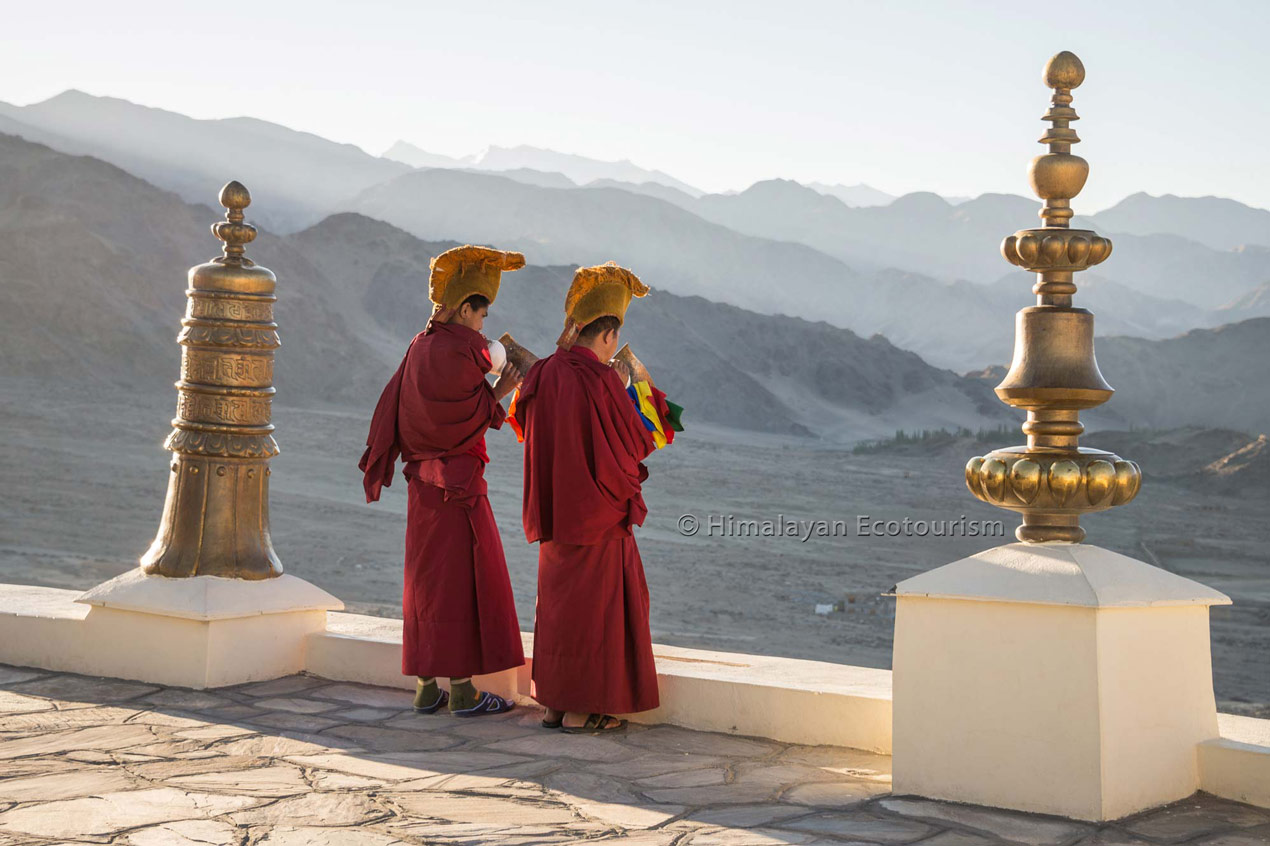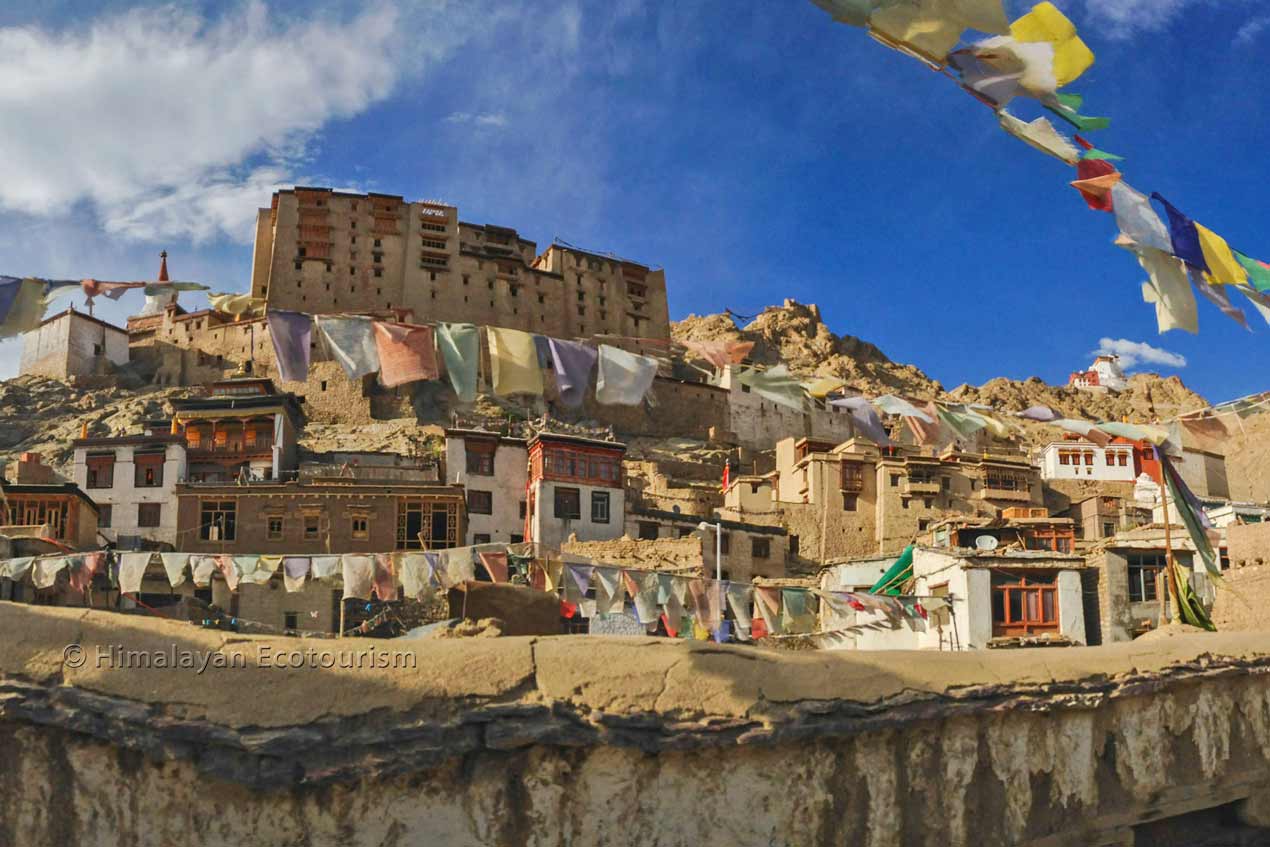Festivals of Ladakh

Monastery Festivals of Ladakh
The Ma Ni Dung Sgrub Festival stands out as a unique and captivating celebration. It literally translates to 100 million recitations. An important dimension of the festival are the horse races. Kyang Gyo Kyarkar is a revered horse figure in the Buddhist pantheon, believed to be a Tulku (reincarnated Lama) that serves as a loyal companion to the mythical King Gesar of Ling. The locals have many legends to narrate about the mythical king and his horse.
Read below more about the different festivals in Ladakh and their importance.
20 Best Festivals of Ladakh
We have listed the 20 best festivals of Ladakh along with the dates on which they fall. You can see the dates below and click on the links on the left to read more about the particular festival
Festival Tours of Ladakh
We are offering unique tours that include experiences of the festivals in Ladakh. These tours are planned to ensure you are at the right monastery on the date of the festival. To check the fixed departures that allow you to enjoy both the landscape and the culture, visit this page. We can also make a customized itinerary if you would like to plan your visit to match the schedule of one of the festivals as listed below in our Festivals of Ladakh 2025-2026
Festivals of Ladakh 2025 and 2026
| Calendar for festivals in Ladakh | |||
|---|---|---|---|
| Festival name | Location | 2025 | 2026 |
| Spituk Gustor | Spituk Monastery | 27-28 Jan | 16-17 Jan |
| Dosmochey Festival | Leh, Diskit, Likir | 26-27 Feb | 15-16 Feb |
| Stok Palace | Stok Guru Tsechu | 08-09 Mar | 25-26 Feb |
| Matho Nagrang Festival | Matho Nagrang Monastery | 13-14 Mar | 02-03 Mar |
| Saka Dawa Festival | All around Ladakh | 11 Jun | 31 May |
| Sindhu Darshan Festival | Shey, Indus riverbank | June | June |
| Yuru Kabgyat | Lamayuru | 22-23 Jun | 13-14 Jun |
| Hemis Festival | Hemis Monastery | 05-06 Jul | 24-25 Jun |
| Shachukul Kabgyat | Shachukul Monastery | 12-13 Jul | 02-03 Jul |
| Stongde Gustor | Stongde Monastery | 12-13 Jul | 03-04 Jul |
| Phyang Tsedup Festival | Phyang Monastery | 22-23 Jul | 12-13 Jul |
| Karsha Gustor | Karsha Monastery | 22-23 Jul | 12-13 Jul |
| Korzok Gustor Festival | Korzok Monastery | 27-28 Jul | 17-18Jul |
| Takthok Festival | Takthok Monastery | 04-05 Aug | 24-25 Jul |
| Naro Nasjal Festival | Sani Monastery, Zanskar | 08-09 Aug | 28-29 Jul |
| Ladakh Festival | Leh and adjoining villages | Sept | Sept |
| Diskit Gustor | Diskit Monastery | 19-20 Oct | 08-09 Oct |
| Thiksey Gustor | Thiksey Monastery | 08-09 Nov | 28-29 Oct |
| Chemrey Wangchok | Chemrey Monastery | 18-19 Nov | 07-08 Nov |
| Losar Festival | All of Ladakh | 20 Dec | 09 Dec |
Ladakhi Calendar
Understanding the Tibetan Calendar : A Blend of Tradition and Astronomy
The 60-Year Cycle: Animal-Element Harmony
Age Calculation : A Tibetan Twist
Diverse Calendar Traditions
Key Facts
-
Lunisolar calendar ensuring harmony between lunar and solar years
-
60-year cycle of element-animal designations
-
Unique age calculation system
-
Three distinct calendar systems: Traditional Lunar, Kalachakra Solar, and Elemental Lunar
Hemis Festival
When is the Hemis Festival celebrated ?
It is a 2-day festival that is usually celebrated at the beginning of the summer.
Where is the Hemis Festival celebrated ?
It is celebrated at the Hemis Monastery which is approximately 50 km from Leh.
Highlights of Hemis Festival
-
Hemis festival: A celebration of Guru Padmasambhava’s birth
-
Traditional attire and vibrant costumes
-
Rare display of precious thangkas
-
Cham dance performance: A spiritual offering to the gods
-
Tantric Buddhism and Tibetan cultural heritage
The Hemis festival , is celebrated to commemorate the birth of Guru Padmasambhava, the founder of Tantric Buddhism in Tibet. Padmasambhava means ‘born from the lotus’.
During the Hemis festival, the locals dress up traditionally. You will see men wearing kamarbands and women with vibrant headgears and ample jewelry.
During the monkey year, which comes in a cycle of 12 years, the four-storeyed thangka of Guru Padmasambhava is hung in the courtyard with other precious thangkas out on display. Thangka is a Tibetan Buddhist painting on cotton/silk fabric.
You may also enjoy a Cham performance. Cham is a lively masked and costumed dance associated with Tibetan Buddhism. The Cham dance form is considered to be an offering to the gods.
Korzok Gustor Festival
When is the Korzok Gustor Festival celebrated ?
It is usually celebrated around the end of July
Where is the Korzok Gustor Festival celebrated ?
At the Korzok Monastery near the Tso Moriri lake.
Highlights of Korzok Gustor Festival
-
Nomadic Gathering
-
Black-Hat Dance
-
Dharmapalas Masks
-
Cultural Heritage
-
Spiritual Significance
-
Unique Blend of Music, Dance & Spirituality
The Chang-pa, nomadic herdsmen from the Tibetan plateau come in large numbers to this festival. The Black-Hat dance is a major highlight of the festival. The Lama dancers wear masks representing Dharmapalas who are the patron divinities of the Drukpa sect of Tibetan Buddhism.
Himalayan Ecotourism arranges everything for the travellers from A TO Z and can guarantee a fun-filled, adventurous trip to the land of high passes.
Losar Festival
When is the Losar Festival celebrated ?
The Losar festival is celebrated in the eleventh month of the Tibetan calendar, which is usually around December
Where is the Losar Festival celebrated ?
It is celebrated throughout Ladakh.
Highlights of Losar Festival
-
Tibetan New Year Celebrations
-
Vibrant Mask Dances
-
Traditional Folk Performances
-
Ancient Rituals & Ceremonies
-
Spiritual Purification & Renewal
The Losar festival , is celebrated for two to three weeks.
The first few days of the festival are most important for the locals as they make offerings to and seek the blessings of the Gods and deities.
This festival is very entertaining and sees the enactment of a lot of ancient rituals and the age-old traditions in the land of the high passes. People also visit their relatives and friends during the Losar festival celebrations.
Sindhu Darshan Festival
When is the Sindhu Darshan Festival celebrated?
Sindhu Darshan is celebrated in the first week of June.
Where is the Sindhu Darshan Festival celebrated ?
On the banks of River Sindhu at Shey.
Highlights of Sindhu Darshan Festival
-
Reverence to the Indus River (Sindhu)
-
Cultural Unity & Harmony
-
Traditional Folk Music & Dance
-
Vibrant Processions & Decorations
Sindhu Darshan festival is celebrated to honor the river Indus. The Indus River which is considered to be the birthplace of Indian civilization appears in many ancient Indian texts as ‘Sindhu’.
In this three-day festival, artists from all over the country are provided a platform to showcase their unique dance performances. Senior Lamas offer prayers on the banks of the river.
Phyang Tsedup Festival
When is the Phyang Tsedup Festival celebrated ?
Usually around the second half of July.
Where is the Phyang Tsedup Festival celebrated ?
At the Phyang Monastery near Leh.
Highlights of Phyang Tsedup Festival
-
Sacred Mask Dances (Cham)
-
Vibrant Costumes & Music
The Phyang Tsedup festival , is celebrated to honor Skyoba Jigten Gombo, the founder of the Drikung Kagyu lineage. Jigten Gombo founded the Drikung Thil Monastery in 1179. The monastery serves as a residence for around 300 monks.
The Cham dance is performed at the celebration. Elegant thangkas including a grand one of Skyoba Jigten Gombo are displayed at the festival.
Dosmochey Festival
When is the Dosmochey Festival celebrated?
Around the second half of Feb.
Where is the Dosmochey Festival celebrated ?
At Leh, Diskit and Likir.
Highlights of Dosmochey Festival
-
Exorcism of Evil Spirits through Rituals
-
Display of Sacred Masks & Costumes
-
Burning of Effigies (representing evil forces)
-
Traditional Fire Puja & Purification Rituals
The 2-day festival is believed to have been started by the royal families in Ladakh to ward off evil. During the festival, the Leh palace is decorated in grandeur, and monks from different monasteries perform a sacred dance.
Traditionally dressed locals and monks and colorfully decorated monasteries are the highlights of the Dosmochey Festival. Senior monks with expertise in Buddhist Tantrism burn dough idols and make thread crosses to keep away the evil forces.
Saka Dawa Festival
When is the Saka Dawa Festival celebrated ?
First half of June
Where is the Saka Dawa Festival celebrated ?
All around Ladakh
Highlights of Saka Dawa Festival
-
Commemoration of Lord Buddha’s Birth, Enlightenment & Nirvana
-
Grand Mask Dances & Cultural Performances
-
Spiritual Processions & Pilgrimages
-
Auspicious Day for Vegetarianism & Compassion
Saka Dawa is the supreme festival of all Buddhists. During the festival, people take part in a procession called Bhumskor wherein they carry articles depicting the life and noble deeds of Buddha.
People engage in meditation and dharma sadhana while refraining from killing animals. The people honor and walk on the path preached by Buddha (Sakyamuni, the sage of the Sakyas)
Naro Nasjal Festival
When is the Naro Nasjal Festival celebrated?
In the middle of the summer
Where is the Naro Nasjal Festival celebrated ?
In the Sani Monastery in Zanskar
Highlights of Naro Nasjal Festival
-
Unique Ritual of Predicting Future Events
-
Ancient Oracle Tradition & Prophecies
The festival begins with the unveiling of the statue of Yogi Naropa who is believed to have meditated at the Kanika Stupa in Sani Monastery. As a ritual offering, the Lamas of the Bardan Monastery perform masked dances.
Himalayan Ecotourism can arrange the best trip to the scenic land of barren mountains and mesmerizing lakes
Takthok Festival
When is the Takthok Festival celebrated ?
In the middle of the summer
Where is the Takthok Festival celebrated ?
In the Takthok Monastery.
Highlights of Takthok Festival
-
Celebration of Guru Padmasambhava’s Life & Teachings
-
Ancient Cave Monastery Setting
- Stunning Himalayan Landscape Backdrop
The Takthok gompa belongs to the Nyingma order, which is the oldest of the four major schools of Tibetan Buddhism.
The Takthok monastery is where Guru Rinpoche meditated and the festival comprises dances and art forms that portray the life of Guru Rinpoche.
Matho Nagrang Festival
When is the Matho Nagrang Festival celebrated?
In the month of March
Where is the Matho Nagrang Festival celebrated ?
In the Matho Nagrang Monastery, Indus valley.
Highlights of Matho Nagrang Festival
-
Oracle Dance & Prophecies
- Matho Monastery’s Exclusive Tradition & Heritage
Matho Nagrang is a very unique festival. It is known as the festival of black oracles. Two oracles are chosen from monks who have been meditating for months and preparing themselves for this special festival. The chosen then give blessings to a large number of people gathered.
Ladakh Festival
When is the Ladakh Festival celebrated ?
In September
Where is the Ladakh Festival celebrated ?
Leh and adjoining villages
Highlights of Ladakh Festival
-
Showcase of Ladakhi Culture & Heritage
- Colorful Costumes & Jewelry Display
-
Archery Competitions & Local Sports
-
Delicious Ladakhi Cuisine & Drinks
The name itself gives you an idea that the festival will be a platform that showcases the diverse cultures of the highland.
The festival is arranged jointly by the locals and the tourism department. Archery, Polo and various other competitions are also held during this festival. People who have come for the fest can enjoy the local barley beer called Chang.
Ladakhi food, handicrafts, folklore dances, traditional music, and the entire festival give tourists a glimpse into the lifestyle of the Ladakhis.

















